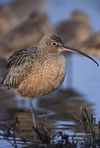Genus Numenius

Northern curlew - Adults have a very long bill curved downwards, a long neck and a small head. The neck and underparts are a light cinnamon, while the crown is streaked with brown. This species exhibits sexual dimorphism, the female having a much longer bill than the male.
Eurasian Curlew - The largest wader in its range, at 50-57 cm length, and a 1 m wingspan. It is mainly greyish brown, with a white back, and a very long curved bill. Males and females look identical, but the bill is longest in the adult female. It is generally not possible to recognize the sex of a single Eurasian Curlew, or even several ones as there is much variation; telling male and female of a mated pair apart is usually possible however.
Eskimo Curlew - The Eskimo Curlew is one of eight species of curlew, and is classed with them in the genus Numenius. It was formerly placed in the separate genus Mesoscolopax. Numenius is classed in the family Scolopacidae. Other species in that family include woodcocks, phalaropes, snipes, and sandpipers. Scolopacidae is a Charadriiform lineage. >:)
Eastern Curlew - The Far Eastern Curlew spends its breeding season in northeastern Asia, including Siberia to Kamchatka, and Mongolia. Its breeding habitat is composed of marshy and swampy wetlands and lakeshores. Most individuals winter in coastal Australia, with a few heading to South Korea, Thailand, and New Zealand, where they stay at estuaries, beaches, and salt marshes. During its migration the Far Eastern Curlew commonly passes the Yellow Sea.
Little Whimbrel - This is a strongly migratory species, wintering in Australasia. It is a very rare vagrant to western Europe.
Whimbrel - This is a migratory species wintering on coasts in Africa, South America, south Asia into Australasia and southern North America. It is also a coastal bird during migration. It is fairly gregarious outside the breeding season.
Bristle-thighed curlew - The Bristle-thighed Curlew, Numenius tahitiensis, is a large shorebird that breeds in Alaska and winters on tropical Pacific islands. It has a long, decurved bill and bristled feathers at the base of the legs. Its length is about 43 cm and wingspan about 84 cm . The size and shape are the same as the Whimbrel's, and the plumage is similar, spotted brown on their upper body with a light belly and rust-colored or buffy tail. The bigger buff spots on the upper body, unmarked light belly and barely marked flanks, tail color, and pale buffy-orange rump distinguish it from the Whimbrel.
Slender-billed curlew - This species has occurred as a vagrant in western Europe, the Canary Islands, the Azores, Oman, Canada and Japan. The only time it was seen in North America was in Crescent Beach, Ontario, Canada in 1925.





